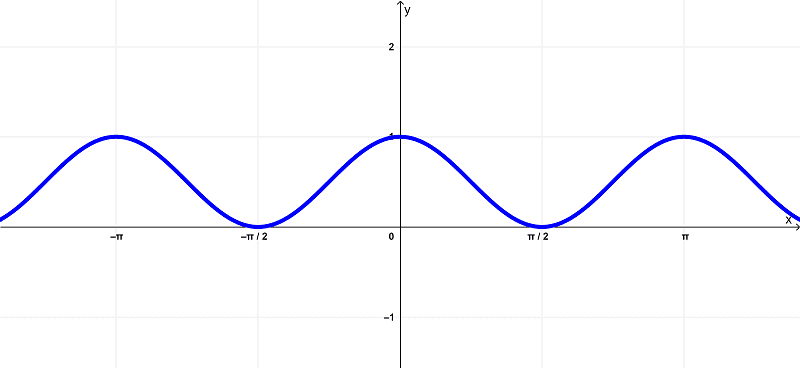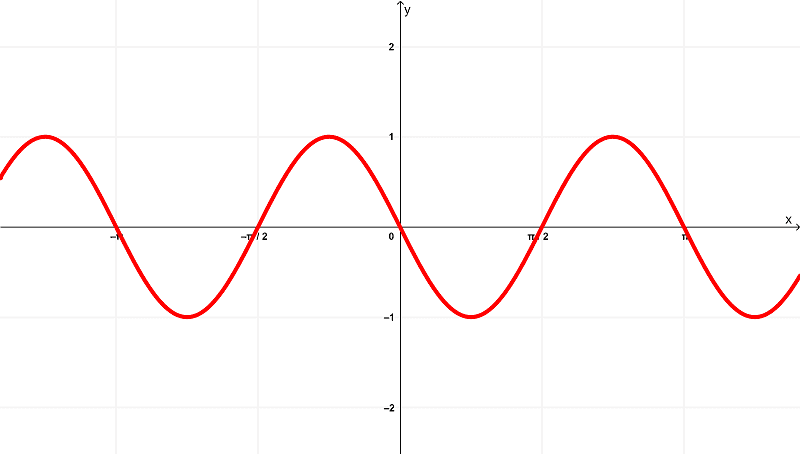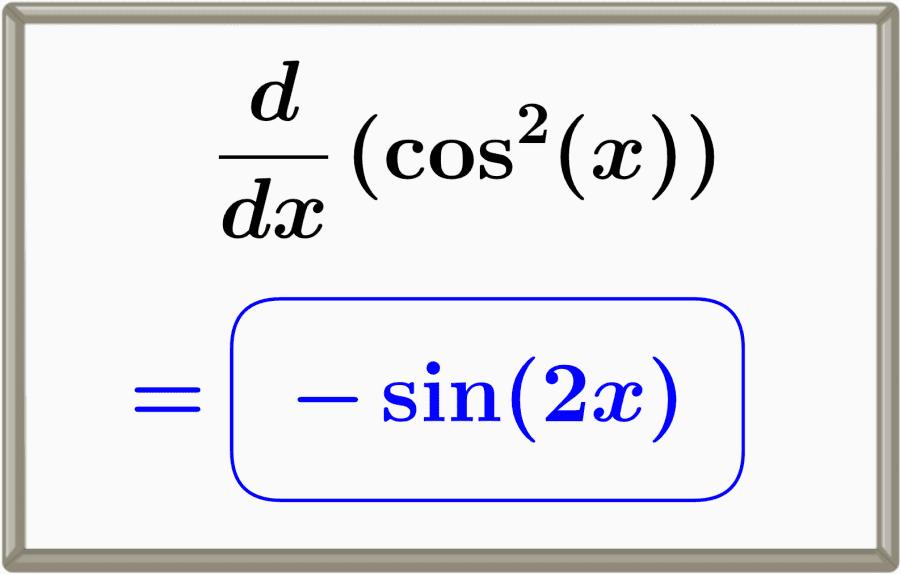The derivative of cosine squared is equal to minus sine of 2x, -sin(2x). We can find or prove this derivative using the chain rule and the derivatives of the fundamental trigonometric functions.
In this article, we will learn how to calculate the derivative of the composite function cosine squared. We will see a proof, the graphical comparison of the cosine squared of x with its derivative, and some examples.
Proof of The Derivative of Cosine Squared Function Using Chain Rule
If you need it, you are encouraged to review the chain rule formula, as a prerequisite of this topic, by visiting this link: Chain Rule of derivatives. Likewise, you may visit this another link for the proof of the derivative of cosine function: Derivative of Cosine, cos(x).
Please take note that
$latex \cos^{2}{(x)} \neq \cos{(x^2)}$
Because it is a composite function, the chain rule formula is used to find the derivative of the cosine squared function.
Therefore, we start with the function
$latex F(x) = \cos^{2}{(x)}$
We can identify the two functions that make up F(x). There is a power function and a trigonometric function in this scenario.
For easier representation, we can rewrite our given as
$latex F(x) = \cos^{2}{(x)}$
$latex F(x) = (\cos{(x)})^2$
It is now very clear that the given power function is the outer function, while the cosine function is the inner function. We can set the outer function as
$latex f(u) = u^2$
where
$latex u = \cos{(x)}$
Setting the trigonometric cosine function as the inner function of f(u) by denoting it as g(x), we have
$latex f(u) = f(g(x))$
$latex u = g(x)$
$latex g(x) = \cos{(x)}$
Deriving the outer function f(u) using the power rule in terms of u, we have
$latex f(u) = u^2$
$latex f'(u) = 2u$
Deriving the inner function g(x) using the derivative formula of trigonometric function cosine in terms of x, we have
$latex g(x) = \cos{(x)}$
$latex g'(x) = -\sin{(x)}$
Algebraically multiplying the derivative of outer function $latex f'(u)$ by the derivative of inner function $latex g'(x)$, we have
$latex \frac{dy}{dx} = f'(u) \cdot g'(x)$
$latex \frac{dy}{dx} = (2u) \cdot (-\sin{(x)})$
Substituting u into f'(u), we have
$latex \frac{dy}{dx} = (2(\cos{(x)})) \cdot (-\sin{(x)})$
$latex \frac{dy}{dx} = -2\cos{(x)}\sin{(x)}$
$latex \frac{dy}{dx} = -2\sin{(x)}\cos{(x)}$
Applying the double angle identities, we have
$latex \frac{dy}{dx} = -(2\sin{(x)}\cos{(x)})$
$latex \frac{dy}{dx} = -(\sin{(2x)})$
This gets us to the cosine squared x derivative formula.
$latex \frac{d}{dx} \cos^{2}{(x)} = -\sin{(2x)}$
Graph of Cosine Squared x VS. The Derivative of Cosine Squared x
The graph of the function
$latex f(x) = \cos^{2}{(x)}$
is

When deriving $latex f(x) = \cos^{2}{(x)}$, we get
$latex f'(x) = -\sin{(2x)}$
which has the following graph

Comparing their graphs, we have:

Using these graphs, we can see that the original function $latex f(x) = \cos^{2}{(x)}$ has a domain of
$latex (-\infty,\infty)$ or all real numbers
and exists within the range of
$latex [0,1]$
whereas the derivative $latex f'(x) = -\sin{(2x)}$ has a domain of
$latex (-\infty,\infty)$ or all real numbers
and exists within the range of
$latex [-1,1]$
Examples
In the following examples, we can learn how to derive composite cosine square functions.
EXAMPLE 1
What is the derivative of the function $latex f(x) = \cos^2(9x)$?
Solution
This is a composite cosine square function, where 6x is the inner function. Then, we can use the chain rule to derive it.
Writing the inner function as $latex u=6x$, we have $latex f(u)=\cos^2(u)$. Then, we use the chain rule as follows:
$$\frac{dy}{dx}=\frac{dy}{du} \frac{du}{dx}$$
$$\frac{dy}{dx}=-\sin(2u) \times 9$$
Substituting $latex u=9x$ back into the function, we have:
$$\frac{dy}{dx}=-9\sin(18x)$$
EXAMPLE 2
Find the derivative of the function $latex F(x) = \cos^2(5x^3-6x)$.
Solution
In this case, the inner function is $latex u=5x^3-6x$. Therefore, we have the outer function as $latex f (u) = \cos^2(u)$.
We start by finding the derivative of the external function
$$\frac{d}{du} ( \cos^2(u) ) = -\sin(2u)$$
Then, we find the derivative of the inner function $latex g(x)=u=5x^3-6x$:
$$\frac{d}{dx}(g(x)) = \frac{d}{dx}(5x^3-6x)$$
$$\frac{d}{dx}(g(x)) = 15x^2-6$$
We apply the chain rule by multiplying the derivative of the outer function $latex f(u)$ by the derivative of the inner function $latex g(x)$:
$$\frac{dy}{dx} = \frac{d}{du} (f(u)) \cdot \frac{d}{dx} (g(x))$$
$$\frac{dy}{dx} = -\sin(2u) \cdot (15x^2-6)$$
Finally, we substitute $latex u=5x^3-6x$ and simplify:
$$\frac{dy}{dx} = -\sin(2(5x^3-6x)) \cdot (15x^2-6)$$
$$\frac{dy}{dx} = -(15x^2-6)\sin(10x^3-12x)$$
Practice of derivatives of cosine square functions


See also
Interested in learning more about the derivatives of trigonometric functions squared? Take a look at these pages:
- Derivative of Sine Squared, sin^2(x) with Proof and Graphs
- Derivative of Tangent Squared, tan^2(x) with Proof and Graphs
- Derivative of Secant Squared, sec^2(x) with Proof and Graphs
- Derivative of Cosecant Squared, csc^2(x) with Proof and Graphs
- Derivative of Cotangent Squared, cot^2(x) with Proof and Graphs




